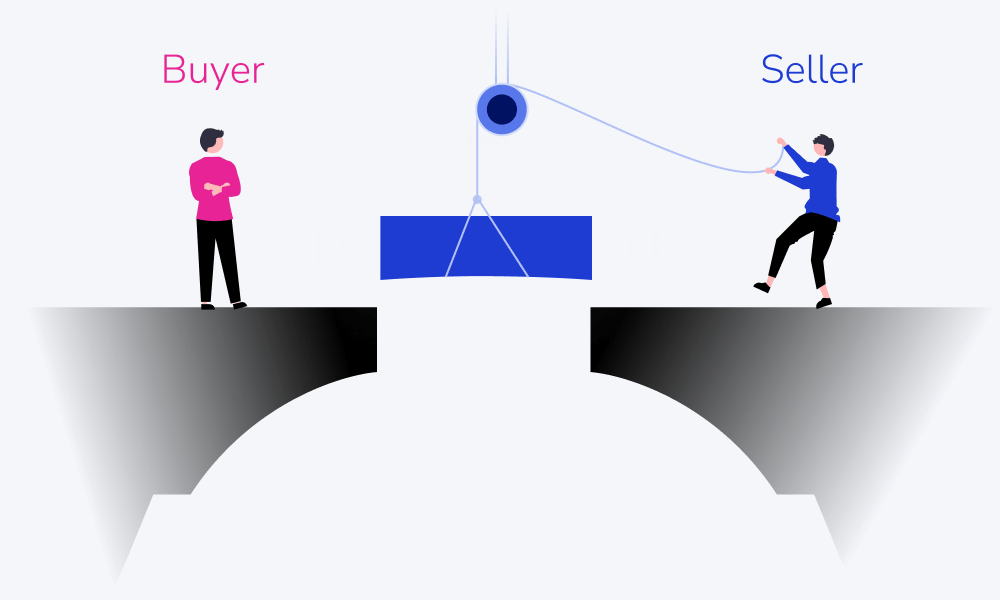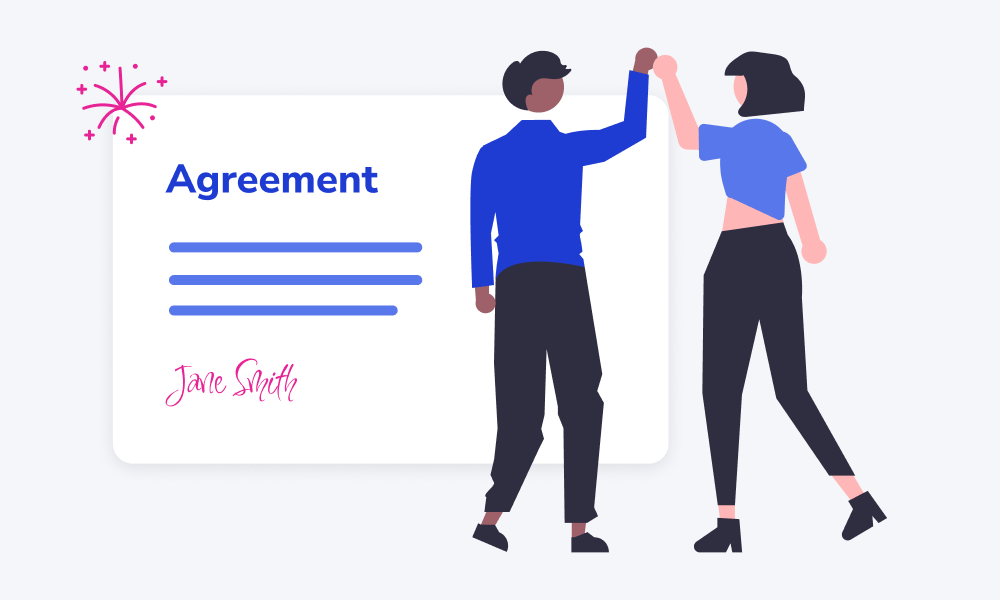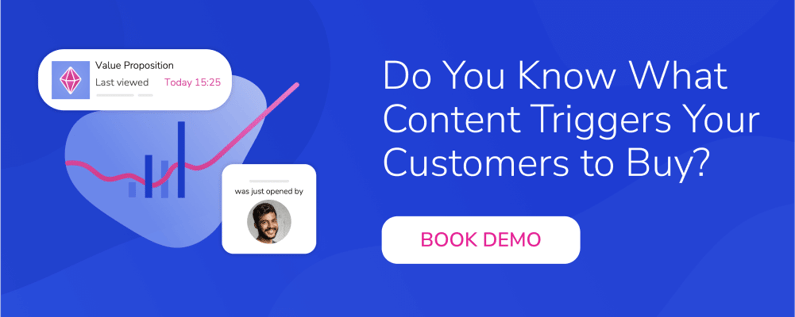Asking for the sale is often the anchor that defines the success of many B2B transactions. It's that pivotal moment, the one where all your hard work, relationship-building, and strategy come to a head.
Yet, for many salespeople, it can also be the most daunting phase in the entire process. Why? Because it's fraught with the possibility of rejection. But, when executed with precision and confidence, it can transform a pitch into a profitable partnership.
So, how do you discern the perfect moment to transition from discussing to closing? And once you’re there, how do you navigate this crucial conversation?
Let’s dive in and arm you with the insights and tools you need to master the art of asking for the sale.
The Psychological Barrier: Why Asking For The Sales is Hard
We've all been there. That moment when our pulse races, palms sweat, and self-doubt creeps in. It's not just about sealing a deal; it's the fear of hearing a 'no' that can cripple even the most seasoned salespeople.
But why is asking for the sale so mentally taxing? It boils down to the deep-seated fear of rejection. This isn't just a sales challenge; it's a human challenge. Rejection can be perceived as a blow to our self-worth and capabilities.
But here's where it gets interesting. In our earlier exploration from our blog, we discovered that buyers, just like sellers, are influenced by a tapestry of cognitive biases. They might be looking for validation of their initial impressions or could be overly risk-averse.

As salespeople, understanding these biases can help us approach the task with more empathy and strategy.
Additionally, the manner of asking matters. Your approach should never make the prospect feel cornered. Phrasing is pivotal. It’s not about pushing but rather guiding the client to see the inherent value in sealing the partnership.
And as you guide, remember that your words, tone, and timing should be as much about serving the client's best interests as they are about closing the deal. This alignment not only eases the psychological weight of the ask but also positions you as a trusted partner rather than just another vendor.
In overcoming the psychological barrier to asking for the sale, the Sales Prospecting Playbook serves as a guiding tool through the intricacies of prospecting. From identifying potential clients to fine-tuning your approach, it provides a strategic foundation. Integrating its insights aligns your sales strategy with client biases, making the ask more attuned to their mindset.
As you navigate sales, incorporating the Sales Prospecting Playbook is key—not just about asking for the sale but approaching it with a strategy aligned seamlessly with client needs and biases.
|
💡 Beyond the evident need for product fit and pricing strategies, understanding the profound interplay between buyer behavior and cognitive biases isn't just an academic endeavor—it's a decisive factor in a salesperson's success. Find out more about The Impact of Buyer Behavior and Cognitive Biases on Sales Performance. |
Recognizing Buying Signals: When to Ask for the Sale
In the symphony of sales, timing is everything. Just like a perfectly placed crescendo can elevate a musical piece, recognizing and acting on buying signals can transform a sales conversation.
But what exactly are these elusive signs? They can range from overt gestures, like a client specifically asking about pricing or delivery timelines, to the subtler nuances, such as a change in their tone, the way they discuss future plans, or increased engagement and responsiveness.
Spotting the Cues
Every sales journey has those golden moments where the prospect subtly, or not so subtly, hints that they're ready to take things to the next level. These cues can often be easy to miss if you're not paying keen attention.
- Verbal Signals: "How quickly can this be implemented?" or "What does the next step look like?"
- Body Language: Leaning in during the discussion, enthusiastic nodding, or increased note-taking.
- Questions: Inquiries about specifics like pricing details, contract duration, or post-purchase support indicate a deeper interest.
Timing is Everything
Aligning with your client’s buying cycle is crucial. If they're in the research phase, being too pushy can scare them off. But if they're in the decision-making phase, waiting too long can mean missed opportunities.
|
💡 Pro Tip: Regularly touch base and ask open-ended questions to gauge where they are in their buying journey. |
Even when you spot buying signals, remember to tread with care. Coming off as too eager can be off-putting, and misinterpreting signals can harm the relationship. For example, just because a client is asking about pricing doesn't always mean they're ready to buy. It could be budgetary planning. Context matters.
As you master the art of reading these signals, the next challenge is how you craft that all-important ask. Let's delve into crafting the ideal environment that fosters trust and paves the way for a seamless transition from discussion to decision.
Perfect Timing: Aligning With Your Customer's Buying Cycle
In the intricate dance of sales, timing is often the unspoken hero. It's not just about what you're selling but also when you pitch it. Understanding and respecting your customer's buying cycle can mean the difference between an eager nod and a polite, "I'll think about it."
As sales professionals, recognizing and adapting to the right rhythm can significantly elevate our pitch's efficacy. So, how do we synchronize our strategies with our customer's tempo?
1. The Buying Cycle: Breaking It Down
- Awareness Stage: At this juncture, the customer realizes there’s an itch they need to scratch. For instance, a company might recognize their outdated software is hampering productivity. However, they might not be aware of the modern solutions available. This stage is your opportunity to gently introduce them to what's out there.
- Consideration Stage: Think of a company comparing cloud storage solutions after a significant data loss. They're not just Googling options; they're actively exploring features, costs, and reviews. Here, your targeted content, webinars, or case studies can position you as a frontrunner.
- Decision Stage: Now, imagine that same company narrowing their choices down to two cloud storage providers. They're on the verge of deciding. This is when your personalized demos, exclusive offers, or customer testimonials can make all the difference.
2. Synchronizing Your Pitch with Their Pace
- Listen Actively: When a client says, "We're currently reviewing our options," they're likely in the Consideration Stage. Recognize such cues to tailor your approach.
- Ask Guiding Questions: A question like, "Have you used a similar solution before?" can reveal if they're entirely new (Awareness) or have some experience (Consideration) with the type of product or service you're offering.
- Be Patient: For instance, if a company is launching a new product line in six months, understand that they might not make immediate decisions about associated services until closer to the launch.
3. Leveraging Tools and Analytics
Modern technology allows for a nuanced understanding of where your potential client might be in their buying journey.
CRM Insights: A prospect who's repeatedly viewed your product demo video might be ripe for a direct conversation or offer.
Email Analytics: If they’re regularly opening your informational content but not decision-driving content, they might still be in the Consideration Stage. For example, consistently reading blog posts but ignoring product comparison sheets could indicate this.
|
💡 Pro Tip: Engagement spikes, like repeated visits to a particular product page or multiple team members from the same company attending your webinar, might indicate an imminent decision. Find out The What, Who, Why and How of Sales Content Analytics. |
As you finesse your understanding of the customer's buying cycle, it’s equally crucial to create an environment where they feel valued and understood. Up next, let's explore how to build that rapport and trust, laying the foundation for a successful sale.
Creating the Right Environment: Building Trust and Value
In sales, trust isn't just a virtue; it's the currency. While you may have the perfect product or service, if your prospects don't trust you, they won't buy from you.
Equally crucial is demonstrating the tangible value your offering brings to the table. So, how do sales leaders construct this ideal environment where trust and value coalesce? And what concrete steps can you take to make your pitch resonate with authenticity and undeniable benefit?

Building Trust
Firstly, trust-building is an art that requires consistency, transparency, and genuine empathy. It begins with the first interaction and should be nurtured throughout the relationship.
For instance, when dealing with a potential client who has reservations about data security, instead of just offering reassurances, provide them with a detailed white paper or a case study showcasing how your solution has bolstered security for similar businesses.
Additionally, proactive communication, such as updating a prospect about a product tweak that might affect them or being candid about potential challenges, can solidify your image as a reliable partner.
Demonstrate Value
On the other hand, demonstrating value is about showing relevance and clear benefits. Tailored presentations are crucial here.
If you're pitching a CRM system to a company with a sprawling sales team, highlight features that specifically address large team coordination and management. Use numbers and real-world scenarios: “Our system has been shown to increase sales team productivity by 20%, which for a team your size could translate to an additional $2 million in annual revenue."
Additionally, anticipate their pain points and show how your solution alleviates them, proving that you're not just selling a product, but a partnership that understands and addresses their unique challenges.
Now that we've talked about cultivating trust and demonstrating value, we're perfectly poised for the next pivotal step. It's the moment of convergence where understanding meets action. Ready to delve into the finesse of crafting that compelling ask? Let's transition into mastering the art of the pitch, ensuring you approach your prospects with both precision and passion.
Techniques for "The Ask": Mastering the Moment of Truth
The culmination of every sales interaction is "The Ask". This decisive moment can be a crescendo of mutual understanding and desire, or it can teeter into an awkward plea. How you approach this can be the difference between a firm handshake deal and a "we'll get back to you."
So, let’s unravel the techniques that can elevate your pitch from merely being heard to being heartily accepted. By refining your approach with the right questions and phrases can make the process feel natural rather than pushy, helping you confidently guide the conversation toward a successful close.
The Soft Ask
Sometimes, it's not about an immediate "yes" or "no." A soft ask can pave the way by gauging interest. Phrases like, "How do you feel about the solutions we discussed?" or "Does this align with what you had in mind?" allow the prospect to express their feelings without the pressure of commitment.
The Consultative Ask
Position yourself as a problem solver, not just a seller. By asking, "Based on your challenges, do you think our advanced package would be a suitable solution?" you're emphasizing the tailored nature of your proposal, showing that you've been listening and understanding their unique needs.
The Direct Ask
While this approach may sound bold, it’s sometimes the most effective, especially if you've built strong rapport. Simply asking, "Would you like to proceed with our service?" can be refreshing in its directness and clarity.
The Assumptive Close
This technique assumes the client is ready to buy. It's especially useful when you've received numerous positive buying signals. For instance, "Shall we discuss the rollout for next month?" presumes that they’re on board and ready to move forward.
Use Visual Aids
Sometimes, a visual representation can make "The Ask" more compelling. If you’re offering a new software solution, a live demo or a comparison chart can bolster your pitch. It allows the prospect to see firsthand the benefits and functionalities, making the decision more tangible.
|
💡 As a sales professional, finding innovative ways to distinguish yourself and make a lasting impression is paramount. Learn How to Use Videos in Sales: 3 Highly Effective Tactics. |
Remember, the essence of "The Ask" lies in confidence, mutual respect, and understanding. It's not just about what you're saying, but how you're conveying it. Body language, tone, and genuine enthusiasm can make a world of difference. And most importantly, be ready for any response. Whether it's a yes, a maybe, or a no, each answer provides an opportunity for growth, feedback, and refinement in your sales journey.
While mastering various techniques for "The Ask" is pivotal, sometimes it's the right questions that can be the game-changer. A well-phrased query can illuminate hidden objections, uncover deeper needs, or simply push the decision over the edge.
Let's delve into essential questions that can be your secret weapon to sealing the deal.
10 Essential Questions You Can Use to Seal the Deal
Sales is kind of like the game of chess; sometimes the most potent move isn't a statement, but a question.
A strategically placed question can draw out invaluable insights, ease concerns, or even help the prospect convince themselves of the decision. Questions can be the mirror that reflects the value you bring, allowing prospects to see it clearly.
So, without further ado, let’s arm you with these questions to help you seal the deal.
1. "What would be the ideal solution for your current challenges?"
This question emphasizes your interest in their specific needs and can also highlight gaps in their current setup that your product or service fills perfectly.
2. "How do you envision our solution integrating with your current processes?"
By prompting them to visualize the integration, you're encouraging them to see the feasibility and advantages of your offering.
3. "Is there something you wish our solution had that we haven’t discussed yet?"
This question can uncover hidden objections or features they're looking for, giving you a chance to address them directly.
4. "What kind of ROI are you expecting from this investment?"
Their answer can guide you in tailoring your pitch to emphasize how your product or service can achieve or surpass this ROI.
5. "How do you feel about the timeline we proposed?"
This ensures that you're aligned in terms of expectations and can adjust if necessary.
6. "Are there any concerns or hurdles preventing us from moving forward?"
Direct and to the point, this question can reveal any lingering doubts they might have, providing you with a golden opportunity to address them head-on.
7. "What's the most important factor in your decision-making process?"
Understanding their priorities helps you emphasize the aspects of your product or service that resonate most with their criteria.
8. "How does our solution compare with others you're considering?"
Not only does this give you a glimpse into the competition, but it also allows you to differentiate and highlight your unique value propositions.
9. "Would a testimonial or case study from a similar client be helpful for you?"
This proactive approach can build credibility and trust, especially if they're on the fence.
10. "What can I do to make this decision easier for you?"
Demonstrating your flexibility and willingness to cater to their needs can be the final nudge they need to commit.
The potency of these questions lies in their ability to provoke thought, encourage dialogue, and guide the prospect towards realizing the inherent value in what you offer. But remember, it's not just about asking—it's about actively listening to their responses, adapting, and providing solutions that truly resonate.
Dealing with Objections and Pushback: Navigating the Rough Waters with Grace
Every seasoned salesperson knows that objections and pushback are not necessarily the end of the road; sometimes, they're just bends on the path to a successful deal. Addressing objections head-on demonstrates not just your product's strength but your conviction in its value. But how do you turn these challenges into stepping stones towards a sale?
Firstly, it's essential to understand the root cause of an objection. Is it a budgetary concern? A question about product capabilities? Perhaps it's uncertainty about implementation or integration? By pinpointing the exact nature of the objection, you can tailor your response to address it directly.
For instance, if a prospect is worried about the steep learning curve of a new software, highlighting features like user-friendly interfaces, 24/7 customer support, and comprehensive training modules can alleviate their concerns.
Moreover, objections are opportunities in disguise. They provide insights into what your prospect truly values. Instead of being defensive, embrace objections as feedback. Engage in an open dialogue, ask probing questions, and listen intently.
Such interactions can often lead to deeper product understanding, solidifying trust and showcasing your dedication to fulfilling their needs. Remember, every objection successfully countered is a step closer to a "yes."
|
💡 Sales resistance is an opportunity to uncover customer needs and develop a solution. By understanding the reasons behind the resistance, you can better build trust and create more successful outcomes. Learn more about How To Interpret and Overcome Sales Resistance in Sales Conversations. |
Beyond The Sale: Nurturing the Relationship for Repeat Business

While the euphoria of a successful sale is unmatched, the journey with your client shouldn't end with a signed contract. In B2B sales, where long-term engagements and partnerships are the norm, the post-sale relationship is pivotal.
Nurturing this bond goes beyond mere follow-ups; it's about consistently adding value, understanding evolving needs, and positioning yourself as a dependable ally in their growth journey. This approach doesn't just enhance client retention, but it can transform one-time clients into brand ambassadors.
By offering periodic check-ins, personalized updates, or even exclusive access to new features or services, you cement your role as more than a vendor - you become an integral part of their success narrative. So, while the initial sale is a victory, the sustained relationship is the championship, and that's where true sales prowess shines.
Conclusion: Mastering the Art of the Sale and Beyond
Navigating the intricate dance of B2B sales requires a blend of psychology, timing, trust-building, adept questioning, and graceful handling of objections. But beyond these tactics lies a deeper truth: that enduring relationships are the bedrock of sustained business success.
As we've explored, the journey doesn't end at the sale. It evolves, thriving on continual engagement and partnership.
Yet, in this dynamic sales landscape, even the most seasoned professionals can benefit from the right tools. Sales enablement platforms, like Showell, empower sales teams to streamline their processes, access vital resources on-the-go, and foster more productive client interactions.
With Showell, not only can you enhance your sales presentations, but you also gain an edge in nurturing those invaluable post-sale relationships.
So, are you ready to elevate your sales game? Experience the transformative power of sales enablement firsthand. Book a demo with Showell today or dive right in and try Showell Free.
Learn next:





.png?width=795&height=318&name=Blog%20banner_%20Get%20Showell%20Free%20(1).png)